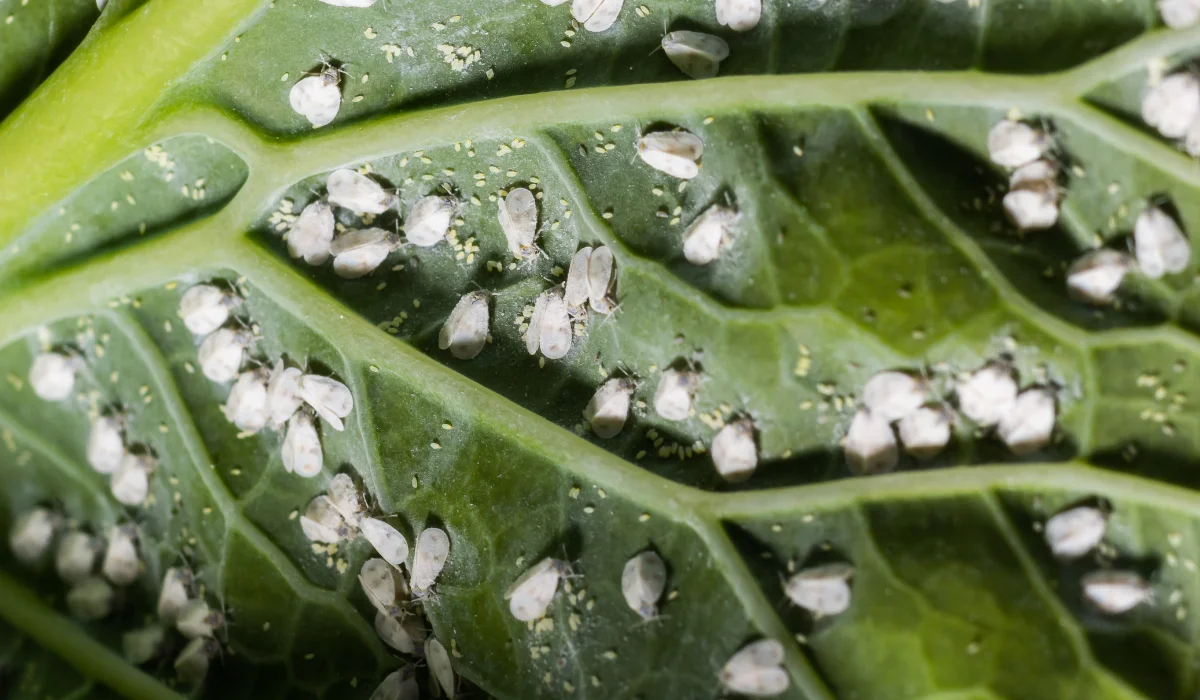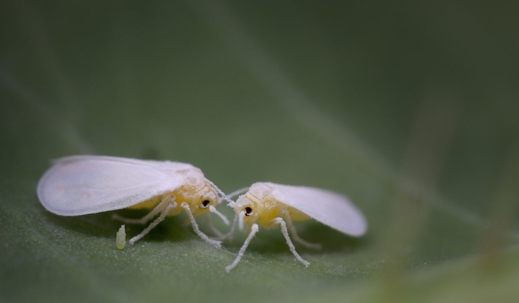Are Whiteflies Harmful to Humans?
Whiteflies are tiny, winged insects that belong to the family Aleyrodidae. They are known for the damage they can do to plants, including the transmission of plant viruses and the weakening of the plant by sucking its juices.
But do these plant pests pose a direct threat to humans? Encouraging an informed perspective is essential, so readers should consider all the facts regarding the relationship between whiteflies and humans.
Key Takeaways
- Whiteflies are primarily agricultural pests and do not pose a direct health risk to humans, as they do not bite, sting, or transmit diseases.
- Visible signs of whitefly presence include tiny white insects on the undersides of leaves, a sticky honeydew substance, and sometimes ants that feed on this honeydew.
- Effective whitefly control options range from natural remedies like neem oil and insecticidal soap to chemical solutions such as systemic and contact pesticides.
- Preventing future infestations involves selecting resistant plants, encouraging natural predators, and maintaining healthy plants to discourage whitefly colonization.
- In severe cases where DIY methods are insufficient, professional pest control services offer more effective solutions for managing whitefly infestations, using advanced treatments not available over the counter.
Whiteflies and Human Health
Whiteflies are known more for their impact on agriculture than on human health. Their presence is conspicuous on plant leaves as they display white wings and powdery coating on their bodies.
Do Whiteflies Pose a Health Risk to Humans?
Contrary to some garden lore, whiteflies do not pose a direct health risk to humans—they are not known to bite, sting, or transmit diseases to people.
Although species of whiteflies like Bemisia tabaci, also known as the sweet potato whitefly, and Trialeurodes vaporariorum can wreak havoc on plants, their interaction with humans is generally harmless.
Here are some truths about these garden pests:
- These insects lack the anatomy to bite or sting.
- There is no evidence that whiteflies carry or transmit diseases that affect humans.
- While whiteflies can enter homes to indoor plants, they are not known to infest human living spaces or cause health issues.
Whiteflies and Plant Health

Whiteflies are frequently found on the undersides of plant leaves, causing extensive damage to various plants, particularly ornamental plants.
How Do Whiteflies Harm Plants?
Here’s how whiteflies harm plants:
Feeding: Whiteflies feed on plants by inserting their needle-like mouthparts into the phloem, extracting their sap.
Honeydew: As they feed, whiteflies excrete a sticky substance known as honeydew. This attracts other pests like aphids, mealybugs, and ants and promotes the growth of sooty mold.
Sooty Mold: This mold detracts from a plant's appearance and can interfere with photosynthesis, weakening the plant.
Signs of Whitefly Damage
Once the eggs hatch, both nymphs and adult whiteflies in the life cycle can spread systemic plant viruses.
Consider these symptoms of damage to the host plant by species like the greenhouse whitefly:
Symptom of Damage | Plants at Risk | Long-term Effect on Plant Health |
Yellowing leaves | Ornamentals like poinsettia | Reduced growth and vigor |
Stunted fertilization and growth | Vegetable crops | Lowered yield |
Formation of sooty mold | Plants with heavy honeydew excretion | Blocked sunlight, inhibited photosynthesis |
Transmission of plant viruses | Wide host range, often crops | Systemic damage, potential crop loss |
Wilting | Plants in warm climates | Plant death in severe outbreaks |
How to Identify Whitefly Infestation
Before whiteflies wreak havoc on plants, getting to know the telltale signs of their presence can save a garden. Here's how you can spot them.
Signs of Whitefly Presence
Whiteflies create a unique challenge due to their preference for the undersides of leaves. If left unchecked, female whiteflies can start an infestation and harm infested plants.
Here’s what you can do:
- Check the Undersides of Leaves: Gently turn over leaves and inspect for tiny, white insects. They tend to gather in clusters, which makes them easier to spot.
- Look for a Sticky Substance: Whiteflies excrete honeydew, a sticky substance you might find on the leaves or under the plant. This can also lead to sooty mold fungus.
- Presence of Ants: Ants feed on the honeydew produced by whiteflies, so their presence around plants can indirectly indicate whitefly infestation.
How to Get Rid of Whiteflies
Depending on the severity and personal preference, natural remedies or chemical solutions can be utilized as whitefly control to manage them effectively.
Natural Remedies
Here are various natural whitefly treatment ideas for controlling whitefly populations in gardens and greenhouses:
Methods | Usage |
Neem Oil | Apply as a spray, targeting infested areas; acts as a growth regulator and repellent. |
Insecticidal Dish Soap | Spray directly onto whiteflies; safe for most plants and beneficial insects. |
Yellow Sticky Traps | Place near affected plants to attract and capture adult whiteflies. |
Petroleum Jelly | Smear on a yellow surface and place near plants as a homemade trap. |
Introducing Predators | Release natural predators like ladybugs or lacewings into the garden to eat whiteflies. |
Chemical Solutions
Chemical solutions should be considered when whitefly populations are large and less responsive to natural methods.
Here's a close look at suggested insecticides for getting rid of whiteflies:
Insecticides | Application Method |
Systemic Pesticides | Apply to the soil for absorption by plants and control of whiteflies via their feeding. |
Contact Pesticides | Spray directly onto whiteflies to kill on contact; reapplication may be necessary. |
Pesticides with Pyrethroids | Use as a spray; effective in quickly reducing whitefly numbers but may not be suitable for all plants. |
How to Prevent Future Infestations
Preventing future infestations and keeping whiteflies away starts with creating an environment that discourages their presence and supports their natural enemies.
Preventative Measures
Here’s how you can establish an unwelcome habitat for whiteflies and promote the well-being of beneficial insects:
Choose plants wisely: Select new plants that are less appealing to whiteflies, such as hibiscus varieties. Inspect new plants thoroughly before introducing them to your garden or indoor space to prevent bringing in whiteflies on leaves or soil.
Encourage beneficial insects: Attracting natural predators like ladybugs, lacewings, and parasitic wasps is pivotal for biological control. These beneficial insects are allies in the garden as they hunt down and feed on whitefly crawlers and eggs.
Maintain healthy plants: Vigorous houseplants are less susceptible to whitefly problems. Ensure proper care through adequate watering, feeding, and lighting, which will create unfavorable conditions for whitefly colonization.
Remove manually: Regularly inspect your plants for signs of whiteflies, especially the undersides of leaves where they lay eggs. Use a stream of water to dislodge young whiteflies, or apply sticky traps around the garden to catch flying adults.
Use insecticidal soaps or horticultural oils: Apply these treatments carefully per the product instructions. When used correctly, these substances can control whitefly numbers without harming ladybugs, lacewings, and other natural enemies.
When to Consider Calling in the Pest Control Experts
In some situations, whiteflies can become more than just a garden nuisance. Although whiteflies are not directly harmful to humans, the widespread use of pesticides to control them can pose health risks.
If you've tried all the DIY methods and the whiteflies just won't leave, it might be time for them to call in a professional pest control company (like us at Native Pest Management). As pest control professionals, we have access to more effective treatments that are unavailable over the counter.
